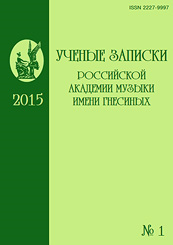Из истории русской музыкальной культуры
Правильная ссылка на статью:
Соломонова О.Б.
О принципах семантизации музыкального текста в опере «Борис Годунов» М.П. Мусоргского
// Ученые записки Российской академии музыки имени Гнесиных.
2015. № 2.
С. 49-58.
URL: https://nbpublish.com/library_read_article.php?id=67029
Аннотация:
Предмет исследования — механизмы семантизации музыки в «Борисе Годунове», главные из которых — «страстн΄ые» риторические фигуры (cаtabasis, passus duriusculus) и жанровые модели плача и славы, имеющие длительную историю интертекстуального существования, а потому — наиболее плотную в информационном отношении семантическую программу. Исследованы кульминационные зоны оперы, связанные с формированием интонационной парадигмы грехопадения–распятия–смерти царя. Выяснено, что многие важные моменты, озвучивающие идею обреченности Бориса, основываются на нисходящем движении в откровенном или латентном виде (в диатоническом, ладово-искаженном, чаще с альтерацией понижения, или хроматизированном варианте, приближенном к риторической фигуре passus duriusculus). Проблематика работы обусловила необходимость адаптации методологических принципов разных наук, главные из которых — семиотический, герменевтический, компаративный, системный методы исследования, а также целостный интонационный анализ. Исследование семантических аспектов «Бориса Годунова» выявило специфику режиссерской работы Мусоргского. Обнаружено, что главные герои оперы, царь Борис и Юродивый, связаны общей интонационной программой, которая основана на музыкальных символах страдания и смерти. Семантически противоположные славильные жанры, соотнесенные с реальними персонажами (Борис, Самозванец, боярин Хрущов), есть увенчания-развенчания. Это антиславления, приводящие к «срыву» славильной семантики (славление Хрущову, хор «Уж как на небе красному слава» с катабасисным «Живи и здравствуй, царь наш батюшка»). Важное исключение — исполняемая каликами Слава Царю Небесному, единственное истинное славление. Доказано, что смысловая динамика рассмотренной жанрово-интонационной символики разворачивается в координатах двух систем: латентно-инверсивной (Пролог) и прямой (сцена под Кромами). Данные семантические акценты, усиленные во второй редакции оперы, — важный режиссерский ход Мусоргского, свидетельство последовательной концепции, направленной на формирование глубинных смысловых интенций.
Ключевые слова:
интонационная семантика, герменевтика, риторические фигуры, катабасис, пассус дириускулус, жанр, плач, слава, режиссура, драматургия
Abstract:
The subject of this research is the mechanisms of semantization of the music in "Boris Godunov", principally the "passionate" rhetorical figures (katabasis, passus duriusculus) and the genre models of lament and glory that have a long history of intertextual existence – and for that reason bear the most consistent information in relation to the opera’s semantic program. The article investigates the culminating zones of “Godunov” associated with the formation of the prosodic paradigm fall–crucifixion–death of the tsar. The author finds that many important points voicing the idea of the doomed nature of Boris are based on downward movement in overt or latent content (diatonic and modal-distorted, often with alteration of the descent or a chromatic variant similar to the rhetorical figure passus duriusculus).The nature of this work has occasioned a need to adapt the methodological principles of various fields of scholarship, chief among them semiotic, hermeneutic, comparative and systematic research methods as well as a holistic intonational analysis.The study of the semantic aspects of "Boris Godunov" reveals the specifics of the directorial work by Mussorgsky. It emerges that the main characters of the opera, Tsar Boris and the Simpleton (Yurodivy), are linked by a common intonational program based on the musical symbols of suffering and death. The semantically opposite glorification genres correlate with real characters (Boris, the Imposter and the boyar Khrushchov), a crowning-debunking. These are anti-glorifications, which lead to a "disruption" of the glorification semantics (the glorification of Khrushchov and the chorus "Glory to the beauty of the sky" with its katabasic "Live and prosper, our King and Father"). An important exception is the Praise to the Heavenly King performed by the kaliki chorus, which is the only true glorification. The author demonstrates that the semantic dynamics of the genre-intonational symbolism under examination unfolds in the coordinates of two systems: latent inverse (Prolog) and direct (the Kroma scene). The given semantic accents, reinforced in the second edition of the opera, make up an important directorial move by Mussorgsky and offer evidence of the consistent concept aimed at the formation of deep semantic intentions.
Keywords:
lament, genre, passus duriusculus, catabasis, rhetorical figures, hermeneutics, intonational semantics, glory, directing, dramaturgy
 Статья опубликована с лицензией Creative Commons Attribution-NonCommercial 4.0 International License (CC BY-NC 4.0) – Лицензия «С указанием авторства – Некоммерческая».
Статья опубликована с лицензией Creative Commons Attribution-NonCommercial 4.0 International License (CC BY-NC 4.0) – Лицензия «С указанием авторства – Некоммерческая». Рус
Рус













 © 1998 – 2024 Nota Bene. Publishing Technologies. NB-Media Ltd.
© 1998 – 2024 Nota Bene. Publishing Technologies. NB-Media Ltd.




